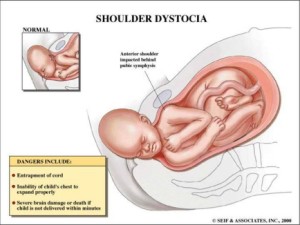Shoulder dystocia is a true emergency in the sense that, time is a critical factor. It needs the necessary expertise within a limited time, no more than minutes, to get a good outcome and prevent an adverse outcome.
What is shoulder dystocia?
 Shoulder dystocia is diagnosed when the shoulders get stuck at the pelvic brim when the head has been delivered.
Shoulder dystocia is diagnosed when the shoulders get stuck at the pelvic brim when the head has been delivered.
This means, the head is out, the baby’s neck is stretched within the birth canal (vagina) and the rest of the baby is stuck within the abdomen.
Size of baby and shoulder dystocia:
While it is true that larger babies are more at risk of shoulder dystocia, it is also true that the majority of cases of shoulder dystocia occur with babies of normal (average) weight. It is very difficult, probably impossible, to accurately predict shoulder dystocia.
Risk factors for shoulder dystocia:
- Gestational diabetes especially with a suspected large baby
- Maternal short stature
- A prolonged second stage of labor despite strong regular contractions
- Previous shoulder dystocia
- Need for instrumental delivery (forceps or ventouse)
- Postmaturity
- A macrosomic (above average size) baby
The idea that recognition of risk factors (above) will facilitate prediction and therefore avoidance of the complication is seductive but ultimately very simplistic and of limited practical value. The vast majority of those who fall within the identified ‘at risk’ groups do actually achieve successful uncomplicated vaginal deliveries. Conversely, most of mothers who experience shoulder dystocia do not have any of the mentioned or any other identifiable risk factors. That is the practical difficulty.
Dealing with shoulder dystocia:
Once recognized, shoulder dystocia calls for immediate action. Obstetricians and midwives involved in delivery will be familiar with the mnemonic HELPERR.
This is meant to help them remember the steps involved in the emergency manoeuvre to deliver the stuck baby. Each letter in the mnemonic represent an action (in sequence) The majority of cases of shoulder dystocia will be overcome using the manoeuvre. Delivery is usually achieved within minutes. Occasionally, injuries can result from these efforts (see next page)
When this manoeuvre fails, a measure of last resort known as the Zavanelli manoeuvrecan be employed. This involves replacing the head back into the abdomen, giving a general anesthetic and performing a cesarean section to deliver the baby.